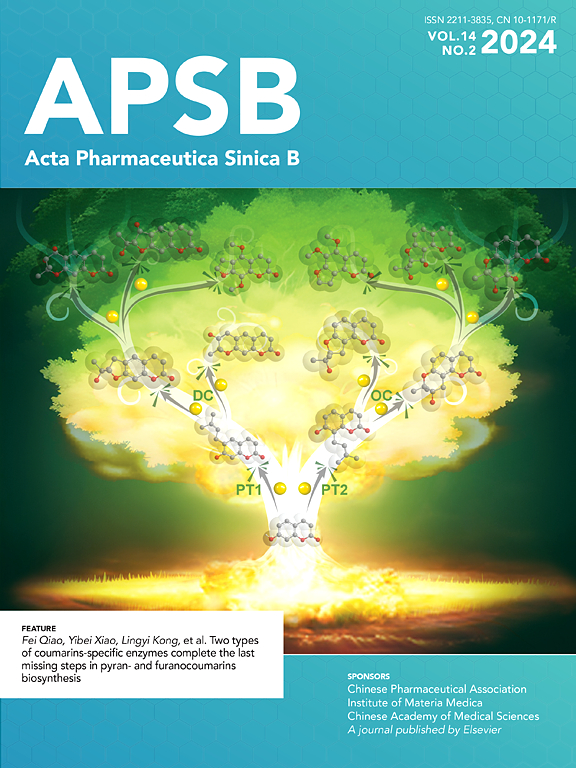一种新的c -3取代齐墩果酸苄基酰胺衍生物通过靶向PA-PB1相互作用和调节宿主巨噬细胞炎症,显示出治疗甲型流感的潜力
IF 14.6
1区 医学
Q1 PHARMACOLOGY & PHARMACY
引用次数: 0
摘要
甲型流感病毒(IAV)以其高传染性和催化全球大流行的潜力而闻名,由于耐药菌株的出现,它构成了重大挑战。鉴于RNA聚合酶在IAV复制中的关键作用,它作为抗IAV治疗的一个有希望的靶点脱颖而出。在这项研究中,我们鉴定了一种新的c -3取代齐墩果酸苄基酰胺衍生物A5,作为PAC-PB1N聚合酶亚基相互作用的有效抑制剂,其IC50值为0.96±0.21 μmol/L。A5特异性靶向高度保守的PAC结构域,对实验室适应和临床分离的IAV菌株(包括多药耐药菌株)均有显著的疗效,EC50值为0.60 ~ 1.83 μmol/L。值得注意的是,当与奥司他韦联合使用时,A5在体外和体内均表现出协同作用。在小鼠模型中,剂量依赖性给药A5导致IAV滴度显著降低,导致治疗小鼠的高存活率。此外,A5治疗抑制病毒诱导的toll样受体4激活,减弱细胞因子反应,并保护巨噬细胞免受iav诱导的炎症反应。综上所述,A5是一种高效、广谱抗流感活性的新型抑制剂。本文章由计算机程序翻译,如有差异,请以英文原文为准。

A novel C-3-substituted oleanolic acid benzyl amide derivative exhibits therapeutic potential against influenza A by targeting PA–PB1 interactions and modulating host macrophage inflammation
The influenza A virus (IAV), renowned for its high contagiousness and potential to catalyze global pandemics, poses significant challenges due to the emergence of drug-resistant strains. Given the critical role of RNA polymerase in IAV replication, it stands out as a promising target for anti-IAV therapies. In this study, we identified a novel C-3-substituted oleanolic acid benzyl amide derivative, A5, as a potent inhibitor of the PAC–PB1N polymerase subunit interaction, with an IC50 value of 0.96 ± 0.21 μmol/L. A5 specifically targets the highly conserved PAC domain and demonstrates remarkable efficacy against both laboratory-adapted and clinically isolated IAV strains, including multidrug-resistant strains, with EC50 values ranging from 0.60 to 1.83 μmol/L. Notably, when combined with oseltamivir, A5 exhibits synergistic effects both in vitro and in vivo. In a murine model, dose-dependent administration of A5 leads to a significant reduction in IAV titers, resulting in a high survival rate among treated mice. Additionally, A5 treatment inhibits virus-induced Toll-like receptor 4 activation, attenuates cytokine responses, and protects against IAV-induced inflammatory responses in macrophages. In summary, A5 emerges as a novel inhibitor with high efficiency and broad-spectrum anti-influenza activity.
求助全文
通过发布文献求助,成功后即可免费获取论文全文。
去求助
来源期刊

Acta Pharmaceutica Sinica. B
Pharmacology, Toxicology and Pharmaceutics-General Pharmacology, Toxicology and Pharmaceutics
CiteScore
22.40
自引率
5.50%
发文量
1051
审稿时长
19 weeks
期刊介绍:
The Journal of the Institute of Materia Medica, Chinese Academy of Medical Sciences, and the Chinese Pharmaceutical Association oversees the peer review process for Acta Pharmaceutica Sinica. B (APSB).
Published monthly in English, APSB is dedicated to disseminating significant original research articles, rapid communications, and high-quality reviews that highlight recent advances across various pharmaceutical sciences domains. These encompass pharmacology, pharmaceutics, medicinal chemistry, natural products, pharmacognosy, pharmaceutical analysis, and pharmacokinetics.
A part of the Acta Pharmaceutica Sinica series, established in 1953 and indexed in prominent databases like Chemical Abstracts, Index Medicus, SciFinder Scholar, Biological Abstracts, International Pharmaceutical Abstracts, Cambridge Scientific Abstracts, and Current Bibliography on Science and Technology, APSB is sponsored by the Institute of Materia Medica, Chinese Academy of Medical Sciences, and the Chinese Pharmaceutical Association. Its production and hosting are facilitated by Elsevier B.V. This collaborative effort ensures APSB's commitment to delivering valuable contributions to the pharmaceutical sciences community.
 求助内容:
求助内容: 应助结果提醒方式:
应助结果提醒方式:


